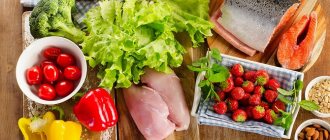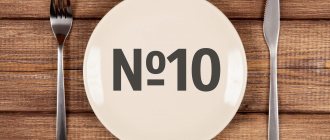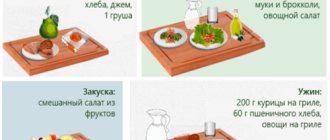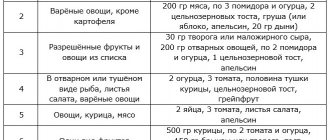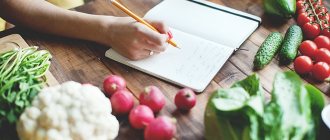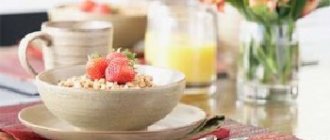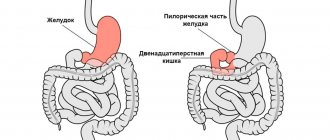The fifteenth diet is a balanced, healthy, complete diet. The diet belongs to a number of therapeutic nutrition systems developed by the Soviet scientist Manuil Pevzner. Using simple rules and requirements, this technique speeds up recovery from illness, improves immunity in adults and children, and normalizes weight. From time to time it is recommended even to healthy people for the prevention of diseases of the gastrointestinal tract, liver, kidneys, and heart.
Application of the treatment program
Diet (table) No. 15 was compiled by Pevzner as a general technique for patients during the period of rehabilitation and recovery. In addition to this technique, the scientist compiled fourteen other, more strict diets, each of which is used for a particular pathology [1]. Table No. 15 is used before switching to a normal diet after more stringent food restrictions.
In sanatoriums, hospitals and resorts, this diet is recommended for people who do not require a special menu. A balanced and nutritious diet compensates for the lack of useful components, relieves stress on the digestive organs and cardiovascular system.
Content:
- Application of the treatment program
- Treatment program rules
- Products for diet
- Prohibited Products
- Wellness menu
- Diet 15g
- Results of a therapeutic diet
Diet No. 15 is used to prevent various diseases. A proper diet strengthens and improves the immune system, increases resistance to viruses, infectious and fungal diseases, so the body is better able to resist pathogens.
The calorie content of the diet is normal, so the treatment table can be prescribed for people who are prone to overeating and weight gain. Due to this technique, a smooth weight loss occurs without loss of useful components and starvation.
In addition, diet number 15 is prescribed after suffering stress, during periods of depression, and neuroses. The list of recommended products contains items that do not irritate the central nervous system and strengthen the nervous system due to magnesium, folic acid, and thiamine.
Indications and contraindications
Table 15 according to Pevzner is intended for people of the following categories:
- those who have had a gastrointestinal disease or surgery (the diet is followed throughout the entire rehabilitation period);
- those in need of strengthening the body’s protective function;
- those leaving a strict therapeutic diet (in this case, table No. 15 is an intermediate stage on the way to normal nutrition);
- needing weight adjustment.
In addition, table No. 15 can be followed to prevent diseases of internal organs, especially the liver and gastrointestinal tract.
There are no contraindications to following such a diet.
Treatment program rules
The principles of the treatment program are designed for the patient’s recovery after illnesses and operations. The main purpose of the diet is to replenish the patient’s weakened body with essential nutrients, vitamins and minerals. It necessarily includes products with a minimum content of preservatives, dyes and flavor enhancers, but at the same time rich in fiber, vitamins, minerals and amino acids.
Also, nutrition should be balanced in terms of the main components of food - proteins, fats and carbohydrates. It is recommended to consume per day:
- 100 g protein;
- up to 400 g of carbohydrates, preferably slow (complex);
- 90 g of fat – mostly vegetable fat.
If the patient is overweight, the amount of fats and carbohydrates is reduced. The calorie intake should be approximately 2500 kcal.
The diet should be structured so that there are 4-5 meals per day. Breakfasts and lunches should be the most nutritious and satisfying; for lunch you should eat up to 35% of the daily value, and leave only 15% for dinner. The last meal should occur no later than 2 hours before bedtime. It is recommended that the volume of dishes is no more than 200-250 ml; for clarity, the food should fit in two palms.
The usual amount of salt should be reduced to 15 g per day; it is advisable to salt food not during cooking, but already prepared dishes. It is recommended to give preference to spices that are not very hot, so as not to excite the nervous system. Store-bought sauces and synthetic seasonings should be abandoned.
It is necessary to maintain a drinking regime to ensure detoxification and rehydration of the body. The average norm is 1.5 liters of water per day. If the diet is used after suffering from kidney or cardiovascular diseases, the doctor should determine the amount of salt and water.
To quench your thirst, you can only use clean water. As for carbonated drinks, periodic consumption of table water with beneficial minerals is allowed. Packaged juices, sweet sodas, and energy drinks should be excluded.
It is important to eat only fresh foods. It is best if the food is prepared before the meal itself. Reheating food is allowed only once, even if it was in the refrigerator.
To strengthen the immune system, you can accompany the diet by taking vitamin complexes, brewer's yeast, and herbal decoctions. It is advisable to use nutritional supplements only after the approval of a doctor.
Facts and myths
About carbohydrates
The first myth that many people believe is that high levels of carbohydrates in the diet contribute to weight gain. To some extent, this is true. However, we are talking only about those elements that are contained in baked goods, sugar, and sweets. On the contrary, carbohydrates contained in vegetables and fruits, whole grain cereals, and herbs are beneficial. It is the latter that are included in diet No. 15.
About food after 18 pm
The second myth is that you should not eat after 6. Ideally, the break between the last meal in the evening and the first after waking up in the morning should be 10-12 hours. If you have to get up at 6 am, your last time at the table should really be no later than 6 pm. If you don’t need to go to work early, and morning sleep lasts until 9-10 am, you are allowed to eat after 18.00.
About periods of fasting
The third myth is intermittent fasting. Of course, this triggers “rejuvenation processes” and reduces the risk of age-related changes, however, after suffering illnesses or surgery, you should not abuse fasting. During the rehabilitation period, the body requires a high-calorie diet.
Products for diet
The diet should be rich in natural, healthy foods. You should give up all synthetic foods, flavorings, dyes, and fast food. Be sure to eat vegetable dishes, fruits, herbs, and berries once or twice a day. Meat and fish products should be chosen of low-fat types and varieties; they should be consumed without skin, fascia, or tendons.
It is recommended to include in your diet:
- Bran, oat, rye bread. White bread can be used, but in small quantities. It is better to eat yesterday's baked goods, dry cookies, biscuits, gingerbread cookies, dried bread, and toast.
- Lean meat and offal. Recommended meat is rabbit, turkey, chicken, pure beef and veal fillet. By-products can be used two to three times a week.
- Lean fish and seafood. All types of shellfish, river and sea fish are suitable. It is important to carefully select these products and avoid spoiled ingredients, fish from contaminated waters, and canned goods with damaged packaging.
- Vegetables and greens. They can be eaten raw in the form of salads or slices, or can be cooked. Greens should be used fresh, with dense leaves.
- Fruits and berries. It is recommended to consume them before lunch, and leave vegetables and protein foods for the second half of the day. It is better to choose sweet and sour varieties and types: pears, grapes, apples, raspberries, currants. Berries and fruits can be eaten whole or made into drinks and desserts.
- Porridge and pasta. All types of cereals are allowed. Pasta and legumes can be included in the diet up to 3 times a week.
- Dairy products. It is better to choose low-fat products, without flavoring additives and dyes. You can use cottage cheese, hard mild cheese, fermented milk drinks. The amount of whole milk should be reduced; you can drink no more than a glass a day; you can add it to dishes or drinks.
- Vegetable oils. Any type of cold-pressed oil is suitable: flaxseed, olive, sunflower, sesame. You can add citrus juice and apple cider vinegar to salad dressings. A small amount of butter is allowed for side dishes.
- Unroasted nuts, seeds.
- Natural desserts. Only homemade sweets made from proven ingredients are allowed: jelly, jelly, molasses, nougat, marmalade, pastries, meringues, meringues. Up to 20 g of dark chocolate is allowed. Pure sugar is limited to 2 teaspoons per day.
- Healthy drinks. Instead of store-bought juices, you need to use homemade compote or fruit drink; sometimes it is useful to prepare decoctions of rose hips, chamomile, linden, and barberry. One serving of coffee with milk or cream is allowed; it is better to switch to decaffeinated analogues.
Given the wide list of foods and dishes recommended by the diet, planning a menu will not be difficult. All natural ingredients provide one benefit or another to restore vitality. A healthy, varied diet combined with adequate drinking will help speed up the body’s recovery and prevent the disease from becoming chronic.
Reviews
On the relevant forums, where people who have suffered from a particular disease share ways to restore the body with nutrition, you can find many reviews about table No. 15 according to Pevzner. Some of them:
She underwent surgery on her stomach to remove erosion. For a long time I was in a hospital setting, where I was prescribed the Pevzner 15 diet. I did not feel any special dietary restrictions. The diet did not include all harmful foods, for example, fatty, fried, too salty, which, in principle, I limited even before I got sick. With the help of the diet, it was possible to restore the functioning of the gastrointestinal tract.
Elizaveta, Moscow
To prevent diseases of the gastrointestinal tract, I stick to table No. 15. I like that you can eat small meals throughout the day, eliminating overeating. I'm happy.
Alexander, Voronezh
After the acute stage of gastritis, I always switch to table 15 according to Pevzner. In addition to the fact that it is possible to restore the functioning of the gastrointestinal tract, extra pounds are also lost. In a week I managed to lose 2 kg. I'm not going to stop there.
Margarita, Kaliningrad
Prohibited Products
The list of prohibited foods for diet No. 15 is not so long. Only preservatives, dyes, flavor and aroma enhancers, and foods that stimulate the central nervous system (coffee, strong green tea, rich meat and mushroom broths, fatty side dishes, spicy, too salty and sour) are excluded.
In order not to overload the stomach, you need to get rid of heavy animal fats: lard, lard, smoked meats, beef and lamb fat. It is better to boil or bake or steam lean meat. Fried foods should be kept to a minimum.
To avoid toxic effects on the body, you should completely avoid purchased crackers, snacks, chips, and peanuts with additives. Sweet sodas, packaged juices, kvass, and instant coffee are excluded.
For the duration of the diet, you need to give up store-bought sauces and hot spices. This includes: mustard, ketchup, mayonnaise, horseradish, Tabasco, turmeric, anise, etc. The use of trans fats is also not allowed, the most common of which is margarine. Avoid foods that contain hazardous cooking oils and additives.
A mandatory requirement for the diet is the abstinence of alcoholic beverages. The toxic and destructive effects of alcohol can completely neutralize the therapeutic effect of the diet.
Principles of dietary nutrition for HD
In addition, fractional meals practically do not cause hunger. The total daily amount of calories should be about 2500 Kcal per day. Reducing it is not recommended, as this can lead to loss of strength.
A nutritionist can correctly calculate the energy value of foods, taking into account the body mass index of a pregnant woman, her physique and other characteristics. The essence of dietary nutrition for gestational diabetes is to ensure that the patient gets enough energy from the food she eats. You also need:
- exclude semi-finished products;
- leave only complex carbohydrates in the diet (porridge, green vegetables and fresh fruits);
- monitor the concentration of glucose in the blood by measuring its level an hour after eating using a special device (glucometer); the data must be recorded.
Many women associate dieting with a lot of restrictions and a constant feeling of hunger. Despite the fact that diet No. 9 imposes restrictions on many foods, a pregnant woman will not starve. The list of permitted products includes:
- turkey and chicken meat;
- rabbit meat, lean beef;
- vegetable broth;
- 2nd meat broth;
- fermented milk products (fat content no more than 10%);
- vegetables and fruits with low GI;
- cereals;
- eggs;
- hazelnuts, walnuts;
- pumpkin and sunflower seeds;
- white sea fish;
- red fish, seafood;
- Champignon.
Pregnant women should not skip meals, so a pregnant woman should plan trips around the city in advance. To satisfy your hunger, you can take nuts or fruits with you.
Strict adherence to table No. 9 is the key to normal intrauterine development of the baby. The diet for gestational diabetes mellitus in pregnant women excludes the following foods from the daily menu:
- sweet pastries;
- wheat flour bread;
- fatty meats;
- pickles, marinades;
- smoked products;
- cashew nuts and peanuts;
- sugar substitutes, honey;
- vegetables and fruits with high GI;
- legumes;
- fermented dairy products;
- store-bought sauces.
Pregnant patients can include the following foods in the menu (no more than several times a week):
- natural yogurt;
- carrots, beet, onions;
- soy based products.
Meal plan
The effectiveness of dietary nutrition during HD also depends on the food intake pattern. Nutritionists recommend that a pregnant woman divide the daily amount of calories as follows:
- 1/4 - breakfast;
- 1/20 - first snack;
- 1/3 - lunch;
- 1/10 - second snack;
- 1/5 - dinner;
- 1/20 - third snack.
A diet for GDM should not deplete the body and at the same time prevent the gain of extra pounds. In the first trimester, weight gain of more than 1 kg per month is considered abnormal. In the second and third trimester - more than 2 kg per month. Excess weight puts stress on the body, increases the risk of edema, increased blood pressure and fetal complications. Try not to overeat or skip meals. The optimal interval between them is no more than 2–3 hours.
The diet for gestational diabetes should consist of protein foods (30–60%), healthy fats (up to 30%) and carbohydrates (40%). Give preference to complex carbohydrates. They are consumed for a long time and do not cause sudden changes in blood glucose levels. Vegetables and fruits with a minimum glycemic index are also required in the diet.
An hour after each meal, measure your blood glucose meter. Record your results in your self-monitoring diary.
Wellness menu
It is very important that the diet is varied. A wide list of permitted products allows you to be creative in preparing dishes. Recovery from illness and surgery will be faster if the diet contains fortified components, plant fiber, and protein. An example of such a menu for a week can be taken from medical websites or created independently.
Monday
Breakfast: pearl barley porridge with pumpkin, tea with milk.
Lunch: lentil and rabbit soup, rye toast, compote.
Afternoon snack: a glass of fermented baked milk.
Dinner: stewed Brussels sprouts, steam cutlet, linden decoction.
Tuesday
Breakfast: semolina with milk, pieces of fresh apricot, tea.
Lunch: vegetarian borscht, buckwheat with boiled mushrooms, bread.
Afternoon snack: baked pear.
Dinner: stuffed fish, mix of lettuce and cucumber, compote.
Wednesday
Breakfast: pancakes with honey, weak black tea.
Lunch: pea soup, bread crackers, pilaf with meat.
Afternoon snack: compote with dried bread.
Dinner: chicken in sour cream, squash caviar, rosehip tea.
Thursday
Breakfast: omelette with tomatoes, bran toast, coffee with milk.
Lunch: broth with noodles and veal, millet porridge with dried apricots.
Afternoon snack: apple juice, unroasted nuts.
Dinner: stuffed peppers, a little sour cream, chamomile tea.
Friday
Breakfast: cottage cheese casserole with raisins, tea.
Lunch: beetroot soup, rice with vegetables, oatmeal bread.
Afternoon snack: yogurt with fresh raspberries.
Dinner: mashed potatoes with meatballs, fresh vegetable salad.
Saturday
Breakfast: pearl barley porridge with apple, bread with cheese, tea.
Lunch: soup with meatballs and vegetables, stewed cabbage.
Afternoon snack: compote, biscuits with seeds.
Dinner: boiled rice, fish with vegetables, fresh pear and apples.
Sunday
Breakfast: soft-boiled eggs, fresh vegetable salad with herbs, toast, tea.
Lunch: cream of mushroom soup, steamed cutlets with buckwheat, bread.
Afternoon snack: a glass of kefir.
Dinner: veal stewed with green beans, jelly.
According to the recipe and method of preparation, dietary dishes are not much different from ordinary ones. Patients who have had to follow this technique at home note that it is easy to follow. The diet menu can be freely used in the family.
Table 15 for children is no different from adult meals. A growing body needs to consume more plant foods and dairy products. It is important to ensure that the child eats all the necessary ingredients: fish, meat, cereals. It is not necessary to force him to eat the entire portion; a small amount is enough. If your child doesn’t like porridge, you can make it sweet and “disguise” meat and fish as an interesting presentation.
Basic Rules
Diet No. 3 is aimed at correcting existing disorders in the body associated with reduced intestinal function. It is sufficiently balanced with all essential nutrients.
The basic principles of the diet include:
Nutrient ratio: 40% - protein foods, 45% - carbohydrates, 15% - healthy fats. Among protein products, lean varieties of meat, poultry or fish should be highlighted. They are all quality sources of good animal protein. From vegetable protein, you should choose those products that can cause less gas (for example, beans). It can be boiled and used as a side dish for meat or added to soup.
The basis of carbohydrates should be a variety of cereals. Oatmeal has an excellent laxative effect. It contains a large amount of plant fiber, which makes the intestines work much faster.
It is necessary to exclude all types of refined foods. The more fiber in food, the better for intestinal motility. Fiber is a natural catalyst for intestinal function. It promotes gentle cleansing, expelling all processed food residues. If your diet contains a lot of fried foods and few vegetables, the intestines begin to work more slowly. The child becomes constipated.
Sufficient drinking regime. A small child needs just enough water to compensate for all the fluid he loses during sweating or breathing. In summer, the body needs much more water. It is impossible to say unambiguously how much a child should drink. It depends on his age, time of year, and also on the region where he lives. A seven-year-old child will need much more water than a three-year-old child
Pay attention if your child asks for a drink or is thirsty. Be sure to give him clean water at room temperature.
What should you add to your diet?
Foods and dishes worth eating:
- day-old wholemeal bread;
- soups are mainly vegetable;
- lean varieties of meat, fish, poultry;
- fermented milk drinks;
- buckwheat, millet, barley cereals in the form of crumbly porridges;
- beets, carrots, tomatoes, cucumbers, zucchini, pumpkin, cauliflower;
- raw fresh sweet fruits and berries in increased quantities;
- honey, jam, marmalade;
- soaked dried fruits (prunes, apricots, figs);
- decoction of rosehip and wheat bran, fruit and vegetable juices.
What should be excluded from the menu?
Eliminate the following foods and dishes from your diet:
- bread made from premium flour, bakery products;
- fatty meats, fish, poultry;
- smoked meats, canned food;
- rice, semolina, vermicelli, legumes;
- radish, radish, garlic, onion, mushrooms;
- jelly;
- blueberries, quince;
- chocolate;
- cream products, hot and fatty sauces;
- horseradish, mustard, pepper;
- cocoa, strong tea;
- animal and cooking fats.
Diet 15g
Table 15g – hyposodium diet. It is used for patients with hypertension in stages I and IIA. In this case, all diet rules and food lists remain the same as in No. 15, but the amount of salt (sodium chloride) is reduced. Additionally, it is recommended to avoid canned food, salted cheeses, sausages, fish caviar, and salted fish.
All dishes are not salted during cooking; bread and other baked goods should be salt-free. The optimal salt intake for hypertension at these stages is a maximum of 7 grams. The patient receives the prescribed amount of sodium chloride in his hands and salts the food as necessary.
General dietary recommendations
The diet for table number 15 should be composed so that the daily calorie content reaches 2600-3100 kcal. This volume is enough to satisfy the energy needs of an adult. Reduce or increase the amount of calories when preparing meals for a child, an elderly person, as well as when increasing physical activity.
The daily volume of BJU should be as follows:
- for protein – 80-100 g, of which 55-60% is allocated to animal protein;
- for fats – 85-100 g, of which 25% is allocated to vegetable fat;
- for carbohydrates - 450-500 g, of which 70-100 g are allocated for pure sugar;
- for table salt – 12-15 g.
If hypertension is diagnosed, the daily amount of salt consumed is reduced to 5-7 g. During the cooking process, salt is not added, but added to portions.
